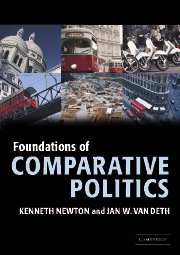Book contents
- Frontmatter
- Contents
- Acknowledgements
- List of briefings
- List of fact files
- List of controversies
- List of tables
- List of figures
- List of abbreviations and acronyms
- Key terms and concepts
- PART I The state: origins and development
- PART II The polity: structures and institutions
- 3 Constitutions
- 4 Presidential and parliamentary government
- 5 Multi-level government: international, national and sub-national
- 6 Policy making and legislating: executives and legislatures
- 7 Implementation: the public bureaucracy
- PART III Citizens, elites and interest mediation
- PART IV Policies and performance
- Glossary of key terms
- Index of names
- Index of subjects
4 - Presidential and parliamentary government
- Frontmatter
- Contents
- Acknowledgements
- List of briefings
- List of fact files
- List of controversies
- List of tables
- List of figures
- List of abbreviations and acronyms
- Key terms and concepts
- PART I The state: origins and development
- PART II The polity: structures and institutions
- 3 Constitutions
- 4 Presidential and parliamentary government
- 5 Multi-level government: international, national and sub-national
- 6 Policy making and legislating: executives and legislatures
- 7 Implementation: the public bureaucracy
- PART III Citizens, elites and interest mediation
- PART IV Policies and performance
- Glossary of key terms
- Index of names
- Index of subjects
Summary
We have seen in chapter 3 that each democratic constitution has its own particular and special features, and that each combines them in a different way. This might produce a severe problem for comparative politics, for if every system was unique then all we could do would be to describe them in bewildering and endless detail. Fortunately for students of comparative politics, this is not the case. The great majority of democracies combine their three branches of government in one of only three general ways – most of them fall fairly neatly into presidential, parliamentary and semi-presidential systems. Of course, each particular democracy retains its own special features, but most nonetheless conform to one of the three general types, and can be classified accordingly.
The first task of this chapter is to map out the three systems and the main differences between them. Since each has its own strengths and weaknesses, the second task is to consider their respective merits and deficiencies. Third, since constitutions do not exist in a societal vacuum, the next job is to try to sort out the form of government best suited to each kind of social and historical circumstances. Some forms of government are more likely to work better in certain conditions than others, and it is also possible that countries might do well to shift from one form to another as they develop over time.
- Type
- Chapter
- Information
- Foundations of Comparative Politics , pp. 60 - 71Publisher: Cambridge University PressPrint publication year: 2005



